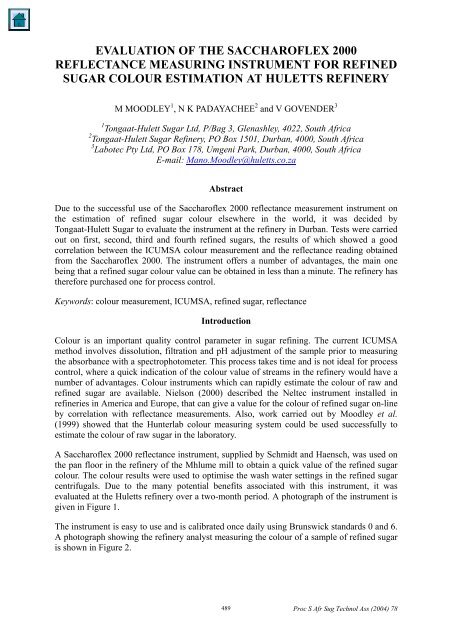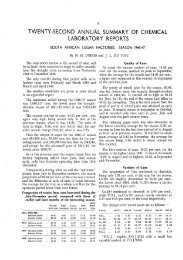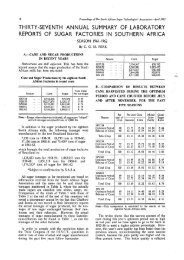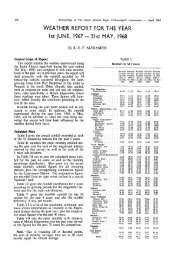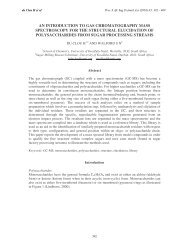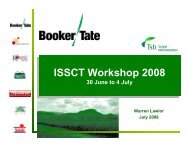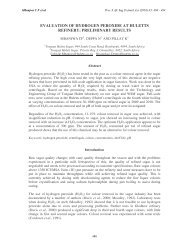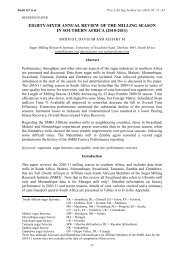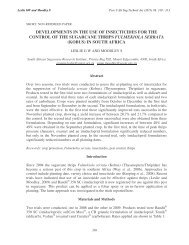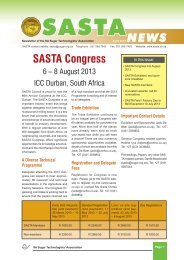Evaluation of the Saccharoflex 2000 Reflectance Measuring ... - sasta
Evaluation of the Saccharoflex 2000 Reflectance Measuring ... - sasta
Evaluation of the Saccharoflex 2000 Reflectance Measuring ... - sasta
You also want an ePaper? Increase the reach of your titles
YUMPU automatically turns print PDFs into web optimized ePapers that Google loves.
EVALUATION OF THE SACCHAROFLEX <strong>2000</strong><br />
REFLECTANCE MEASURING INSTRUMENT FOR REFINED<br />
SUGAR COLOUR ESTIMATION AT HULETTS REFINERY<br />
M MOODLEY 1 , N K PADAYACHEE 2 and V GOVENDER 3<br />
1 Tongaat-Hulett Sugar Ltd, P/Bag 3, Glenashley, 4022, South Africa<br />
2 Tongaat-Hulett Sugar Refinery, PO Box 1501, Durban, 4000, South Africa<br />
3 Labotec Pty Ltd, PO Box 178, Umgeni Park, Durban, 4000, South Africa<br />
E-mail: Mano.Moodley@huletts.co.za<br />
Abstract<br />
Due to <strong>the</strong> successful use <strong>of</strong> <strong>the</strong> Sacchar<strong>of</strong>lex <strong>2000</strong> reflectance measurement instrument on<br />
<strong>the</strong> estimation <strong>of</strong> refined sugar colour elsewhere in <strong>the</strong> world, it was decided by<br />
Tongaat-Hulett Sugar to evaluate <strong>the</strong> instrument at <strong>the</strong> refinery in Durban. Tests were carried<br />
out on first, second, third and fourth refined sugars, <strong>the</strong> results <strong>of</strong> which showed a good<br />
correlation between <strong>the</strong> ICUMSA colour measurement and <strong>the</strong> reflectance reading obtained<br />
from <strong>the</strong> Sacchar<strong>of</strong>lex <strong>2000</strong>. The instrument <strong>of</strong>fers a number <strong>of</strong> advantages, <strong>the</strong> main one<br />
being that a refined sugar colour value can be obtained in less than a minute. The refinery has<br />
<strong>the</strong>refore purchased one for process control.<br />
Keywords: colour measurement, ICUMSA, refined sugar, reflectance<br />
Introduction<br />
Colour is an important quality control parameter in sugar refining. The current ICUMSA<br />
method involves dissolution, filtration and pH adjustment <strong>of</strong> <strong>the</strong> sample prior to measuring<br />
<strong>the</strong> absorbance with a spectrophotometer. This process takes time and is not ideal for process<br />
control, where a quick indication <strong>of</strong> <strong>the</strong> colour value <strong>of</strong> streams in <strong>the</strong> refinery would have a<br />
number <strong>of</strong> advantages. Colour instruments which can rapidly estimate <strong>the</strong> colour <strong>of</strong> raw and<br />
refined sugar are available. Nielson (<strong>2000</strong>) described <strong>the</strong> Neltec instrument installed in<br />
refineries in America and Europe, that can give a value for <strong>the</strong> colour <strong>of</strong> refined sugar on-line<br />
by correlation with reflectance measurements. Also, work carried out by Moodley et al.<br />
(1999) showed that <strong>the</strong> Hunterlab colour measuring system could be used successfully to<br />
estimate <strong>the</strong> colour <strong>of</strong> raw sugar in <strong>the</strong> laboratory.<br />
A Sacchar<strong>of</strong>lex <strong>2000</strong> reflectance instrument, supplied by Schmidt and Haensch, was used on<br />
<strong>the</strong> pan floor in <strong>the</strong> refinery <strong>of</strong> <strong>the</strong> Mhlume mill to obtain a quick value <strong>of</strong> <strong>the</strong> refined sugar<br />
colour. The colour results were used to optimise <strong>the</strong> wash water settings in <strong>the</strong> refined sugar<br />
centrifugals. Due to <strong>the</strong> many potential benefits associated with this instrument, it was<br />
evaluated at <strong>the</strong> Huletts refinery over a two-month period. A photograph <strong>of</strong> <strong>the</strong> instrument is<br />
given in Figure 1.<br />
The instrument is easy to use and is calibrated once daily using Brunswick standards 0 and 6.<br />
A photograph showing <strong>the</strong> refinery analyst measuring <strong>the</strong> colour <strong>of</strong> a sample <strong>of</strong> refined sugar<br />
is shown in Figure 2.<br />
Proc S Afr Sug Technol Ass (2004) 78
Results and discussion<br />
Samples <strong>of</strong> refined sugars were analysed for colour by <strong>the</strong> ICUMSA method, and <strong>the</strong><br />
reflectance was measured using <strong>the</strong> Sacchar<strong>of</strong>lex <strong>2000</strong> to generate <strong>the</strong> calibration data. The<br />
results are plotted in Figure 3.<br />
Figure 1. The Sacchar<strong>of</strong>lex <strong>2000</strong> colour measuring system.<br />
Figure 2. Huletts refinery analyst using <strong>the</strong> Sacchar<strong>of</strong>lex <strong>2000</strong> instrument<br />
to read <strong>the</strong> reflectance <strong>of</strong> a refined sugar sample.<br />
Proc S Afr Sug Technol Ass (2004) 78
ICUMSA Colour<br />
90<br />
80<br />
70<br />
60<br />
50<br />
40<br />
30<br />
20<br />
10<br />
0<br />
0 0.5 1 1.5 2 2.5 3 3.5 4 4.5<br />
Sacchar<strong>of</strong>lex <strong>2000</strong> reflectance readings<br />
Figure 3. Sacchar<strong>of</strong>lex <strong>2000</strong> reflectance measurements versus ICUMSA colour values.<br />
The results show a good correlation between <strong>the</strong> reflectance readings and <strong>the</strong> ICUMSA<br />
values. The linear regression equation is as follows:<br />
ICUMSA colour = 17.39 x reflectance reading + 9.14 (1)<br />
r 2 = 0.81, n= 218<br />
The average difference between <strong>the</strong> ICUMSA colour and <strong>the</strong> colour value calculated from <strong>the</strong><br />
reflectance measurements was less than 1%. This was not considered significant for process<br />
control.<br />
The equation that was derived by Mhlume ( 1 personal communication) is as follows:<br />
ICUMSA colour = 14,75 x reflectance reading + 10,38 (2)<br />
For <strong>the</strong> tests done at <strong>the</strong> refinery laboratory <strong>the</strong> equation derived by Mhlume was also used to<br />
calculate <strong>the</strong> ICUMSA colour. The average difference <strong>of</strong> <strong>the</strong> estimated refined sugar colour<br />
between <strong>the</strong> two equations was 3 units <strong>of</strong> colour.<br />
The Sugar Milling Research Institute (SMRI) prepared 12 samples, which included a pair <strong>of</strong><br />
duplicates <strong>of</strong> refined sugar for colour measurements. The ICUMSA colour was done by both<br />
<strong>the</strong> SMRI and TMD laboratories on <strong>the</strong> samples. The reflectance <strong>of</strong> <strong>the</strong> refined sugar samples<br />
was also measured, and equation 1 was used to estimate <strong>the</strong> ICUMSA colour value. The<br />
results are given in Table 1.<br />
The following comments can be made regarding <strong>the</strong> results in Table 1:<br />
! There was no significant difference (t-test) between <strong>the</strong> colour values measured by <strong>the</strong><br />
SMRI and TMD laboratories. The duplicates (6 and A, 9 and B) agreed reasonably well.<br />
1 L Govender, Mhlume Sugar Mill<br />
Proc S Afr Sug Technol Ass (2004) 78
! Most <strong>of</strong> <strong>the</strong> colour values estimated by <strong>the</strong> Sacchar<strong>of</strong>lex <strong>2000</strong> agreed reasonably well<br />
with <strong>the</strong> values measured by <strong>the</strong> SMRI and TMD except samples 9 (duplicate B) and 10.<br />
The colour results as estimated by <strong>the</strong> Sacchar<strong>of</strong>lex <strong>2000</strong> for samples 9, B (duplicates)<br />
and 10 were higher than <strong>the</strong> ICUMSA colour values. No reason could be found for this.<br />
The duplicates (6 and A, 9 and B) agreed reasonably well.<br />
Table 1. Comparison <strong>of</strong> colour results.<br />
Sample SMRI TMD<br />
Sacchar<strong>of</strong>lex<br />
<strong>2000</strong><br />
1 38 40 40<br />
2 40 40 42<br />
3 44 43 40<br />
4 45 41 42<br />
5 38 37 36<br />
6* 24 26 24<br />
7 32 35 29<br />
8 34 44 37<br />
9 # 73 68 42<br />
10 43 46 28<br />
A* 24 27 23<br />
B # 73 61 41<br />
*Duplicates<br />
# Duplicates<br />
The results <strong>of</strong> <strong>the</strong> investigation showed that <strong>the</strong> Sacchar<strong>of</strong>lex <strong>2000</strong> can be used successfully<br />
to estimate <strong>the</strong> colour <strong>of</strong> refined sugar for process control purposes, and <strong>the</strong> instrument has<br />
<strong>the</strong>refore been in use in <strong>the</strong> laboratory since October 2003.<br />
The refinery generally boils four white massecuites. Prior to 1991, <strong>the</strong>se boilings were<br />
combined to produce <strong>the</strong> final refined sugar. In 1991 <strong>the</strong> twin streaming system, where most<br />
<strong>of</strong> <strong>the</strong> first and second refined sugars were sent to <strong>the</strong> silo and <strong>the</strong> rest <strong>of</strong> <strong>the</strong> refined sugars<br />
were combined to produce <strong>the</strong> H1 stream, was implemented. As a result <strong>of</strong> this, <strong>the</strong> number<br />
<strong>of</strong> colour analyses carried out per shift increased from 8 to 26.<br />
A typical hour in <strong>the</strong> laboratory sees <strong>the</strong> following procedures being followed:<br />
! The four white boilings are received from <strong>the</strong> pan house.<br />
! The samples are analysed for colour.<br />
! The results <strong>of</strong> <strong>the</strong> individual sugars are entered into <strong>the</strong> colour balance programme in <strong>the</strong><br />
computer which determines <strong>the</strong> way <strong>the</strong> sugar from <strong>the</strong> centrifugals should be blended to<br />
produce <strong>the</strong> required refined sugar quality.<br />
The total process takes about 45 minutes, and it is possible that some refined sugar which is<br />
out <strong>of</strong> specification could be sent to <strong>the</strong> packaging department. This ‘<strong>of</strong>f-spec’ sugar would<br />
have to be rejected, incurring re-processing costs.<br />
When compared with <strong>the</strong> ICUMSA method, <strong>the</strong> time taken to obtain a colour value with <strong>the</strong><br />
Sacchar<strong>of</strong>lex <strong>2000</strong> is reduced from 10 minutes to one minute.<br />
Benefits <strong>of</strong> <strong>the</strong> Sacchar<strong>of</strong>lex <strong>2000</strong><br />
! Reduction in time to do <strong>the</strong> measurement <strong>of</strong> colour from 10 to 1 minute.<br />
! Possibility <strong>of</strong> some labour saving.<br />
! Reduction in chemical cost amounting to between R40 000 and R80 000 per annum.<br />
Proc S Afr Sug Technol Ass (2004) 78
! Possibility <strong>of</strong> reduction in amount <strong>of</strong> reject sugar due to quick colour measurement.<br />
! Can be used by process to optimise centrifugal wash water settings.<br />
Conclusion<br />
The results showed that colour estimated by <strong>the</strong> Sacchar<strong>of</strong>lex <strong>2000</strong> was comparable with <strong>the</strong><br />
colour obtained by <strong>the</strong> ICUMSA method, and <strong>the</strong> instrument can <strong>the</strong>refore be used for<br />
process control.<br />
Due to <strong>the</strong> benefits <strong>of</strong> <strong>the</strong> instrument, and based on a pay-back period <strong>of</strong> one year, <strong>the</strong><br />
refinery has purchased an instrument for process control.<br />
Acknowledgements<br />
The authors would like to thank G Marie from <strong>the</strong> refinery laboratory who carried out <strong>the</strong><br />
numerous colour analyses. The input from B Schoonees from <strong>the</strong> SMRI and L Govender<br />
from <strong>the</strong> Mhlume mill is also appreciated.<br />
REFERENCES<br />
Moodley M, Dunsmore A and de Jager L (1999). <strong>Evaluation</strong> <strong>of</strong> <strong>the</strong> Hunterlab colour<br />
measuring instrument. Proc S Afr Sug Technol Ass 73: 272-276.<br />
Nielson BC (<strong>2000</strong>). Recent developments and new applications <strong>of</strong> in-line colour<br />
measurements on crystalline sugar. Sug Ind Technol pp 227-232.<br />
Proc S Afr Sug Technol Ass (2004) 78
Proc S Afr Sug Technol Ass (2004) 78


